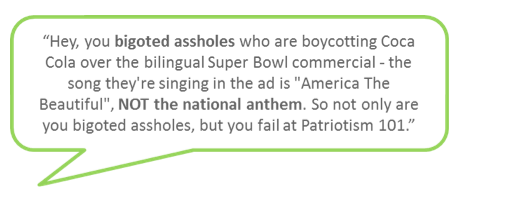By Michalis A. Michael
Whenever something unexpected happens in life, some of us pause, we look up and we try to figure it out. Especially if you are curious – like good researchers are supposed to be – discovering a paradox can lead to a hypothesis and looking to prove it can be real fun. When we came across the Coca-Cola Superbowl ad paradox, we investigated and analysed it to death. We then started thinking about similar cases that may support our hypothesis i.e negativity brought out by a relative minority, under certain circumstances, may have a positive effect through awakening the majority.
On February 2nd 2014 (the day of the Superbowl ), Coca-Cola aired an ad where people of various ethnicities were singing ‘America the Beautiful’ in their own language. Immediately after the airing of the ad, all hell broke loose on Twitter and other social media platforms; this continued for the following days and weeks.
According to DigitalMR’s findings, during the 8 days prior to the Superbowl there were 139,997 posts about Coca-Cola in the English language: 22% Negative, 7% Positive, and 71% Neutral; during the 8 days following the airing of the ad, the number increased by 169% to 376,382 posts. The interesting finding here is that although the number of posts increased by 169% after the campaign airing, the amount of negative posts still accounted for 22% of the total while positive posts jumped to 51%.
The number of neutral comments is the same before and after at ~100,000; the only difference is its share had dropped to 1/3 of what it was, from 71% to 27%.

What we discovered had actually happened was almost unbelievable, at least for it to have occurred organically; apparently, the initial negative reaction from some consumers had the opposite effect than what they were trying to achieve. Instead of influencing others in preventing them from buying Coca-Cola products and encouraging them to go against the company, they managed to “wake up” many passive consumers that watched the Coca-Cola ad to come to its defense.
Reading through a large number of posts, we saw that although many were assigned a negative sentiment by the listening247 algorithms, they were not negative towards Coca-Cola or the ad, but rather towards the posts attacking the ad and by extension, the brand.
These people not only defended the message behind the brand’s multilingual ad celebrating diversity, they went as far as to directly attack the negative and often racist comments and the people behind them. Through this process of manually going through posts, we identified a new sentiment: the double negative, or indirectly positive.
You see, just like in mathematics, in our view the double negative can be considered as positive. Once we identified the posts that were directly positive about the campaign, as well as the posts that were negative towards the negative comments i.e. the comments attacking the racists and thus defending Coca-Cola (indirectly positive), the results were totally different. The “neg-neg” plus the positive accounted for the largest percentage of posts in total.

As you can see, the directly and indirectly positive posts are overtaking the negative and neutral ones, especially on blogs.
Good social media listening tools can help a brand investigate the market and understand its needs and beliefs in order to predict the negative and double negative reactions, and avoid unwanted social media situations.
Now is not the time for organisations to be asking themselves whether they should be monitoring and analysing social media, the right questions should be: “who should be the owner of Social Analytics, do we currently have someone with the right skill-set, what tools should we be using, and how can we help elevate it to the higher executive levels in order to ensure success?”.
By Michalis A. Michael, DigitalMR, Connect with Michalis via @DigitalMR, his personal @DigitalMR_CEO or via email mmichael@digital-mr.com
References:
Michalis A. Michael & Sophia Papagregoriou (2014) The Positive Effect of Negativity [Online] Available at: http://cdn2.hubspot.net/hub/186045/file-1371807469-pdf/docs/DigitalMR_The_Positive_Effect_of_Negativity_v0.pdf





5 comments
I found something interesting and learned here “Positive Effect of Negativity”. I will surely share this to my network and thanks for sharing
Hi.
I am a big fan of your blog. I had read many of your great articles and learn great techniques and methods to do proper research. This information again is very interesting and all case studies are very inspiring.
Nice concept though it help us to understand what big brands are actually do to remain top.
These are awesome tips, thanks for sharing
Interesting take on “The Positive Effect of Negativity”, I am convinced with the logic you suggest. Love to read your blog. Keep posting such great insights.